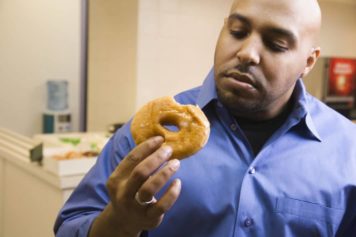For Demetris Dennis Taylor, being overweight has been a lifetime problem.
“I’ve always been big,” he said. “Even when I was in high school, I was a size 34 while some of the rest of my friends were a 28 or a 29.”
Taylor, 45, grew up in Detroit where eating large meals was just a part of the lifestyle. Unfortunately, those same meals were part and parcel of his relatives having heart disease, diabetes and other maladies attributed to high cholesterol and sodium found in soul food.
“I tried all the diets. When I tried to exercise, it would come off, but I would get bored with that,” said Taylor. “I tried this one diet where you could lose fifty pounds in six weeks, but I only lost thirty-five in eight weeks because I didn’t follow it all the way through.”
In 1999, Taylor began having complications from a hernia that started to grow in his stomach. The doctor refused to operate because Taylor’s health insurance did not provide for the surgery. The physician’s professional suggestion was for Taylor to tape a silver dollar to his navel, and only worry about the hernia if it hardened.
Thirteen years later, Taylor, who stands 6 foot 4 inches tall, had gotten as heavy as 470 pounds, and felt forced by his doctors to shrink his stomach by 75 percent in order to make room for repairing an umbilical hernia in his midsection. Though he lost weight fast, the Internet blog radio host also lost a great deal of strength in his body.
“Since having the surgery, there was another complication,” said Taylor. “A part of my intestines began to gangrene. I was walking dead.”
Today, almost three years after nearly losing his life, Taylor is clear that if his doctor had not insisted that he have gastric surgery, he would not have undergone something so invasive.
Stateofobesity.org states that “nearly 40 percent of middle-aged adults, ages 40 to 59, were obese (39.5 percent), compared with younger adults, ages 20-39, (30.3 percent) or older adults, ages 60 and over.”
A layperson may ask why don’t they just workout harder or eat better, but a person in Taylor’s position runs the risk of further damaging his surgical scars if he partakes in any greater activity than walking.
Mayo Clinic stated in an April 2015 article that “3,500 calories equals about 1 pound (0.45 kilogram) of fat, you need to burn 3,500 calories more than you take in to lose 1 pound.” That equates to cutting your consumption by 500 calories per day within a week. The article also that the drawback of cutting calories in losing weight is the loss of lean body tissue and water. However, foods with higher proteins and lower calories will help to maintain energy.
Robin Grant, who has worked in various ends of the fitness industry since 1997, said that body image issues cut both ways. “I know men who look they have body that other men and women would worship to have,” said said, “but what they don’t see is how much that same man pinches to see if he is fit enough. They don’t see how many times he runs to the scale.”
Grant, 41, said that she used to make fun of her mother for knowing when the rain was coming by a feeling she had in her knee. Now, though she is in above average physical shape, aches and pains sometimes plague her in the knees, her back or ankle as just another part of getting older while maintaining an active life. She recommends that people looking to maintain a fitness regimen also have a stretch regimen.
“When I go out with my friends, someone might ask where Robin is,” she said. “Oh, she’s in the bathroom stretching.”
Grant said that for a person in Taylor’s position a trainer would have to do their homework. “For someone like him, I would have had him walk on a treadmill at a low speed on an incline in order to work on his core without harming his condition,” she said. “A trainer and client relationship is just like dating. If you’re hurting in your arms from lifting, then, that’s a good hurt. If you’re hurting someone else other than what we worked on, that’s a problem that we need to fix together.”
While Grant doesn’t recommend gastric bypass or anything invasive to lose weight, she feels that the key to success is in celebrating the small gains that a client makes in their fitness journey. “You may not see the scale moving, but look at your cheekbones. Your pants fit differently,” she said. “You can’t become so obsessed by weighing yourself because you will drive yourself crazy. It takes about six weeks once you start a consistent regimen in order to see any progress.”
Grant, who has fitness classes in Snellville, said that with the right combination of diet, exercise, and working with a knowledgeable trainer, someone waging their war against weight can see a difference over time.


